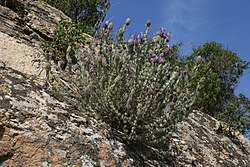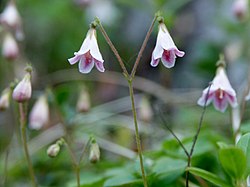Subshrub


The term subshrub (
Because the criteria are matters of degree (normally of height) rather than of kind, the definition of a subshrub is not sharply distinguishable from that of a shrub; examples of reasons for describing plants as subshrubs include ground-hugging stems or low growth habit. Subshrubs may be largely herbaceous though still classified as woody, with overwintering perennial woody growth much lower-growing than deciduous summer growth. Some plants described as subshrubs are only weakly woody and some persist for only for a few years; others however, such as Oldenburgia paradoxa live indefinitely (though is still vulnerable to external effects), rooted in rocky cracks.
Small, low shrubs such as
Definition
A chamaephyte, subshrub or dwarf-shrub is a plant that bears hibernating buds on persistent shoots near the ground – usually woody plants with
- ecosystems on nutrient-poor soils or rock[3]
- exposed alpine or arctic ecosystems where seasonal or perennial wind and freezing conditions are prone to kill vulnerable growing shoots[4]
- ecosystems subject to frequent fires and burning, where many species of e.g. Banksia or Eucalyptus regrow from a lignotuber or caudex.[5]
- heavily grazed or overgrazed ecosystems, such as tortoise turf[6]
Examples of chamaephytes
The term chamaephyte is most formally used within the context of
See also
References
- ^ Harris, James G.; Harris, Melinda Woolf (2001). Plant identification terminology: an illustrated glossary (2nd ed.). Spring Lake, Utah: Spring Lake Publishing. p. 117.
- ^ Jackson, Benjamin, Daydon; A Glossary of Botanic Terms with their Derivation and Accent; Published by Gerald Duckworth & Co. London, 4th ed 1928
- ISBN 9780444418098. Archivedfrom the original on 2 April 2023. Retrieved 13 October 2016.
- PMID 21669698
- ISBN 978-0-521-82491-0. Archivedfrom the original on 2023-04-02. Retrieved 2016-10-13.
- ^ Israel Journal of Botany. Weizmann Science Press of Israel. 1975. Archived from the original on 2023-04-02. Retrieved 2016-10-13.
- PMID 21652418
